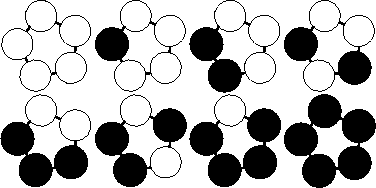poj 2409 Let it Bead(polya 定理)
来源:互联网 发布:兰州知行学院官网 编辑:程序博客网 时间:2024/06/04 18:55
Description
A bracelet is a ring-like sequence of s beads each of which can have one of c distinct colors. The ring is closed, i.e. has no beginning or end, and has no direction. Assume an unlimited supply of beads of each color. For different values of s and c, calculate the number of different bracelets that can be made.
Input
Output
 For each test case output on a single line the number of unique bracelets. The figure below shows the 8 different bracelets that can be made with 2 colors and 5 beads.
For each test case output on a single line the number of unique bracelets. The figure below shows the 8 different bracelets that can be made with 2 colors and 5 beads.Sample Input
1 12 12 25 12 52 66 20 0
Sample Output
123581321
Source
[Submit] [Go Back] [Status] [Discuss]
题解: polya 定理




其实每一种项链的方式就是一个置换,注意这里的置换是位置的置换与颜色无关。但是这些置换中有很多都可以通过一些项链旋转或翻转的方式得到,那么我们需要计算的是不同等价类(所谓等价类就是对于一般的置换群G,k在G中置换的作用下的‘轨迹’形成一个封闭的集合,称为等价类,记为Ek。等价类之间可以互相转化。对于G= {(1)(2)(3)(4), (12), (34), (12)(34)},显然有E1=E2={1,2},E3=E4={3,4}。注意(12)表示的是置换中变换的是1、2,3,4与原序列保持不变,那么很显然e1,e3是相互独立的,因为无论怎么变化e1,e3都不可能相同。所以第一个和第三个不是等价类。)的个数。这道了polya定理,如何确定置换和置换的循环节呢?
如果s(表示珠子的个数)是奇数,则存在s种置换(对于这个环的题确定置换的个数就是确定对称轴数,这时只考虑翻转对称),每种置换包含s/2+1个循环(因为两边的数是两两对称,当前对称轴上的数单独属于一个循环节,所以是s/2+1)。
如果s是偶数,存在s/2种以边的中点为中心轴的翻转,每种包含s/2个循环(对称轴左右两两对称,另外还存在s/2种以点为中心的翻转,每种包含s/2+1个循环(对称轴上的两个数单独属于一个循环,其他的数两两对称);
旋转:旋转i个珠子得到的循环数为gcd(i, s) ,一共可以旋转s 次
证明:设初始值为x,每次旋转i个珠子。有序列:x, x + i, x + i*2, ... , x + i*t
假设x + i*t的时候回到原位置,即 x = (x + i*t)%n -> i*t%n = 0;
也就是 t*i = 0(mod n)
解这个线性同余方程。
d = gcd(n, i);
i'x - n'y = 0/d;
e = x*(0/d)%n = 0;
解的剩余系:e, e + n/d, e + n/d*2 ... e+n/d*(d-1);
发现解的剩余系中第一个有效的解为t = n/d = n/gcd(n, i);
所以旋转i个珠子得到的循环长度为t = n/gcd(i, n),
所以旋转i个珠子得到的循环数为n/t = gcd(i, n);
#include<iostream>#include<cstdio>#include<algorithm>#include<cstring>#define LL long long using namespace std;LL ans,n,m;LL gcd(LL x,LL y){LL r;while (y){r=x%y;x=y;y=r;}return x;}LL pow(LL num,LL x){LL base=num; LL ans=1;while (x){if (x&1) ans=ans*base;x>>=1;base=base*base;}return ans;}int main(){while (scanf("%lld%lld",&n,&m)!=EOF){if (!n&&!m) break;ans=0;for (LL i=1;i<=m;i++) ans+=pow(n,gcd(m,i));if (m%2) ans+=pow(n,m/2+1)*m;else ans+=pow(n,m/2+1)*(m/2), ans+=pow(n,m/2)*(m/2);printf("%lld\n",ans/(m*2));}}- POJ 2409 Let it Bead Polya定理
- POJ 2409 - Let it Bead【Polya定理】
- poj 2409 Let it Bead Polya定理
- poj 2409 Let it Bead(polya定理)
- poj 2409 Let it Bead(polya 定理)
- 置换群Polya定理(poj 2409: Let it Bead)
- POJ 2409 Let it Bead(Polya定理)
- POJ 2409 Let it Bead(polya)
- 【POJ 2409】 Let it Bead(Polya)
- POJ 2409 Let it Bead (Polya)
- POJ 2409 Let it Bead polya 定理 和 置换
- 【裸polya定理】poj 2409 Let it Bead
- poj 2409 Let it Bead Polya波利亚定理
- 2409 Let it Bead //polya 定理
- POJ 2409-Let it Bead(Polya定理-旋转+翻转 串项链)
- POj 2409 Let it Bead ----- polya计数
- POJ 2409 Let it bead 【裸polya】
- poj 2409 Let it Bead Polya计数
- css3笔记
- 安卓面试
- Android 如何监听输入法关闭事件
- vs2013在win10上安装color theme editor失败
- 使用cx_freeze工具打包时提示 AttributeError 'module' object has no attribute '_fix_up_module':
- poj 2409 Let it Bead(polya 定理)
- 数据结构 -图
- R语言之拿到数据要做的第一件事
- C语言变量内存分布
- python EndUpdateResource问题
- 端口转发
- Android 属性动画详解
- SQL SERVER 系统函数
- css3笔记


